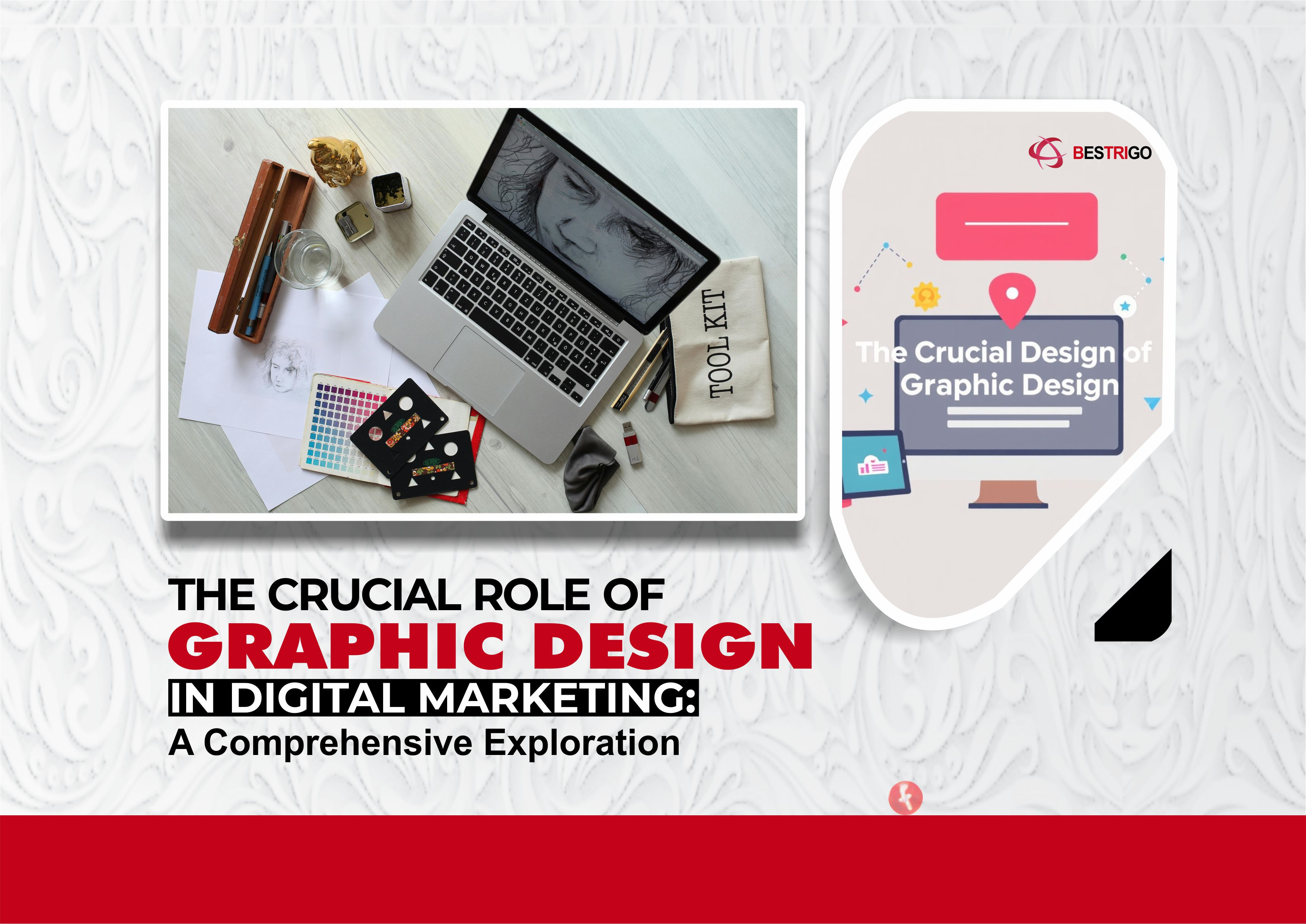In today's interconnected digital landscape, graphic design has become a cornerstone of effective branding and marketing. It's not merely about crafting aesthetically pleasing visuals but about strategically communicating a brand's message and forging meaningful connections with target audiences. This comprehensive article explores the growing importance of graphic design in digital marketing, emphasizing how it can enhance branding, influence customer perceptions, and drive business success.
What Is Graphic Design?
Graphic design is an artistic discipline that focuses on creating visual content to communicate messages. It employs a range of elements, including typography, imagery, color, and layout, to present information in a way that is engaging and easy to understand. According to the Interactive Design Foundation, “Graphic design is the craft of creating visual content to communicate messages. By applying visual hierarchy and page layout techniques, graphic designers use typography and pictures to meet users' specific needs and focus on optimizing the user experience.”
This form of design is ubiquitous, influencing everything from the layout of a website to the design of a product label. Its primary goal is to convey complex information clearly and compellingly, making it a vital tool in both consumer and business communication.
The Integral Role of Graphic Design in Digital Marketing
In the realm of digital marketing, graphic design serves several critical functions that contribute to a brand's success. It acts as the visual representation of a company’s identity and plays a pivotal role in shaping consumer perceptions. Here’s an in-depth look at why graphic design is essential for digital marketing:
1. Building a Unique Brand Identity
Graphic design is fundamental in establishing a brand's visual identity. Just as a red carpet outfit makes a statement, the visual elements of a brand—such as its logo, color scheme, and typography—create a distinctive identity that differentiates it from competitors. A well-designed logo, for instance, is not just a symbol but a visual shorthand for the brand's values and ethos.
When businesses invest in professional graphic design, they can develop a cohesive and recognizable brand image that fosters familiarity and trust with their audience. This consistency across various marketing materials—be it a website, social media, or print advertisements—helps build a strong and memorable brand presence.
2. Communicating Messages Visually
The adage "A picture is worth a thousand words" underscores the power of graphic design in communication. Visuals often capture attention more effectively than text alone. For example, a well-designed infographic can simplify complex data into easily digestible insights, making it more accessible and engaging for the audience.
Graphic design is crucial for creating visual content that resonates with viewers and reinforces brand messages. Take, for example, the iconic Apple logo, which communicates the brand’s essence and values without needing accompanying text. This power of visual communication can make a significant impact on a brand's ability to convey its message quickly and effectively.
3. Enhancing Sales and Brand Perception
Humans are inherently visual creatures, and high-quality design can significantly influence purchasing decisions. Effective graphic design can create a sense of trust and credibility, suggesting that a company’s products or services are of high quality. For instance, a professionally designed business card or brochure can enhance the perceived value of a company and leave a positive impression on potential clients.
Good design doesn’t just catch the eye; it also influences behavior. Well-designed marketing materials—such as engaging product packaging or compelling advertisements—can drive customer interest and boost sales. By investing in high-quality design, businesses can enhance their overall marketing strategy and improve their market position.
4. Delivering Brand Messages Across Channels
Graphic design plays a crucial role in ensuring that brand messages are consistently communicated across various channels. This includes designing materials such as reports, charts, and promotional content that align with the brand’s identity and messaging strategy. Effective graphic design helps maintain brand consistency, which is essential for building and reinforcing brand recognition.
For example, a marketing agency like Color Whistle can leverage its design expertise to create cohesive branding elements that resonate across different platforms, from social media ads to email newsletters. This consistency helps to reinforce the brand's message and ensures that it reaches the audience in a unified and impactful manner.
5. Breaking Down Language Barriers
In an increasingly globalized world, graphic design is a powerful tool for overcoming language barriers. Visual content transcends linguistic differences, making it an effective means of communicating with a diverse audience. Whether it's through infographics, icons, or visual storytelling, graphic design can convey messages that are universally understood, regardless of the viewer’s primary language.
This ability to communicate visually is particularly important for businesses aiming to reach a global audience. By using compelling design elements, companies can engage with people from different cultural backgrounds and ensure that their messages are effectively communicated across borders.
Leveraging Graphic Design in Digital Marketing
To maximize the impact of graphic design in digital marketing, businesses need to understand the various types of design that can be employed and how they can be utilized effectively. Here’s an in-depth look at different types of graphic design and their applications:
1. Visual Identity or Branding Design
Visual identity design involves creating elements that represent a brand's personality and values. This includes designing logos, selecting color palettes, and choosing typography that aligns with the brand's identity. Tools like Adobe Photoshop, Illustrator, and InDesign are commonly used to craft these elements, which play a crucial role in establishing a brand’s visual presence.
A well-designed visual identity helps create a strong and memorable brand image. It ensures that all branding materials—whether digital or print—are consistent and reflective of the brand’s core values. This consistency helps to build brand recognition and foster customer loyalty.
2. Advertising and Marketing Graphic Design
Advertising and marketing graphic design encompasses a wide range of materials used to promote products and services. This includes designing:
- Postcards and Flyers: Effective for direct marketing and local promotions.
- Infographics: Simplify complex information and make it more engaging.
- Newsletters and Annual Reports: Communicate important updates and achievements.
- E-books and Brochures: Provide in-depth information about products or services.
- Email Marketing Templates: Ensure consistent and visually appealing communication.
- Social Media Ads and Banners: Capture attention and drive engagement on digital platforms.
These design elements are crucial for influencing consumer behavior and enhancing the effectiveness of marketing campaigns. By investing in high-quality design, businesses can create more engaging and persuasive marketing materials that resonate with their audience.
3. User Interface (UI) Design
User interface design focuses on creating visually appealing and user-friendly digital interfaces. This includes designing elements such as:
- Web Pages: Ensure an intuitive and aesthetically pleasing user experience.
- App Designs: Enhance functionality and user interaction within mobile applications.
- Game Interfaces: Create engaging and interactive experiences for users.
- 3D Modeling: Add depth and realism to digital products.
Effective UI design involves optimizing visual elements like size, color, and placement to improve the overall user experience. A well-designed interface can significantly impact user satisfaction and drive higher engagement with digital products.
4. Motion Graphic Design
Motion graphics combine graphic design with animation to create dynamic and engaging content. Examples include:
- Digital Advertisements: Capture attention with animated visuals.
- Animated Logos: Enhance brand recognition with motion.
- Promotional Videos: Convey messages in a compelling and memorable way.
- Tutorial Videos: Provide instructions in an engaging format.
- Websites and Banners: Use animations to enhance user interaction and visual appeal.
- GIFs: Add a touch of creativity and fun to digital content.
Motion graphics are increasingly popular due to their ability to capture attention and convey messages in a dynamic and engaging manner. They are widely used across digital platforms to enhance visual storytelling and drive audience engagement.
Industries Relying on Graphic Design
Graphic design is not confined to traditional sectors like corporate branding and marketing. Its impact spans across various industries, including:
- Education: Design of educational materials, online courses, and e-learning platforms.
- Fashion: Creation of lookbooks, product catalogs, and promotional materials.
- Mobile Apps: User interface design for apps across different platforms.
- E-commerce: Product images, website design, and digital advertising.
- Travel & Tourism: Promotional materials, travel guides, and booking interfaces.
- Government Agencies: Public information campaigns, reports, and official documents.
- Packaging and Manufacturing: Product packaging design and branding.
- Software Development: User interface design for software applications and digital tools.
In every sector, graphic design plays a crucial role in enhancing communication, branding, and customer engagement. From a small local business to a global corporation, the principles of effective graphic design are universally applicable.
Conclusion
Graphic design is a powerful tool in digital marketing, essential for building a compelling brand presence and effectively communicating messages. It influences consumer perceptions, enhances marketing efforts, and drives business success. By leveraging graphic design strategically, businesses can create memorable and impactful visual content that resonates with their target audience and stands out in a competitive marketplace.
Understanding the significance of graphic design and its various applications can help businesses make informed decisions about their marketing strategies. Investing in high-quality design not only enhances brand identity but also contributes to overall marketing effectiveness, driving growth and success in today’s digital landscape.



0 Comment